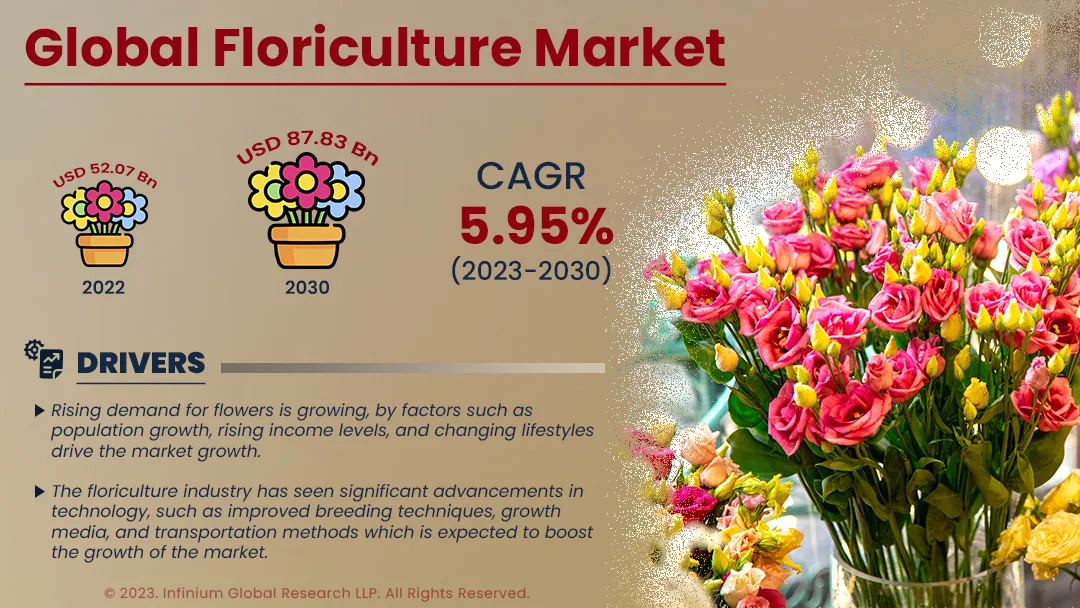Floriculture Market (Type - Cut Flower, Loose Flower, Bedding & Garden Plants, Potted Flowering Plants, and Foliage Plants; Distribution Channel - Retail, Florists, Supermarkets/Hypermarkets, Online, and Others; Application - Aesthetic & Decorative Purposes, Flavours & Fragrances, Natural Colors, Medicines, and Others; End Use - Personal, Institutions/Events, Hotels, Restaurants & Spas, Industrial, and Others): Global Industry Analysis, Trends, Size, Share and Forecasts to 2030
A recent report published by Infinium Global Research on floriculture market provides in-depth analysis of segments and sub-segments in the global as well as regional floriculture market. The study also highlights the impact of drivers, restraints, and macro indicators on the global and regional floriculture market over the short term as well as long term. The report is a comprehensive presentation of trends, forecast and dollar values of global floriculture market.
Market Insight:
The floriculture market refers to the industry that produces and sells flowers and ornamental plants for use in decoration, landscaping, and other purposes. This includes a wide range of products, from cut flowers and potted plants to seeds and other plant materials used in horticulture. The global floriculture market is a large and diverse industry, with a wide range of products and players. Key players in the market include major flower growers and distributors like Dümmen Orange, Syngenta Flowers, and Ball Horticultural Company, as well as smaller growers and retailers specializing in specific flower types or regions. The market is driven by a number of factors, including changing consumer preferences for natural and sustainable products, increasing demand for flowers and plants for use in weddings and other special events, and growing interest in indoor gardening and other horticultural activities.
The growing demand for decorative plants in various end-use industries, including events, hospitality, and home decor, is driving the growth of the floriculture market. This demand is driven by changing consumer preferences, as more people seek to incorporate natural elements into their living and working spaces. As disposable incomes rise in many parts of the world, consumers are increasingly able and willing to spend money on luxury goods, including flowers and ornamental plants. Advances in greenhouse technology, including automated irrigation and climate control systems, are allowing floriculture producers to improve their yield and reduce costs, making the production of flowers and ornamental plants more efficient and profitable. The floriculture market is highly seasonal, with demand for flowers and ornamental plants peaking during holidays and other special occasions. This seasonality can create challenges for producers, who must plan their production schedules carefully to avoid overproduction or shortages. The floriculture market has an opportunity to capitalize on the growing demand for sustainable and eco-friendly products. By promoting the environmental benefits of natural flowers and plants, the industry can appeal to consumers who are increasingly concerned about the environmental impact of their purchases.

Europe is a significant market for floriculture products, with countries like the Netherlands, Italy, Spain, and Germany being major producers and consumers of flowers and ornamental plants. The Dutch floriculture industry is particularly significant, with the country accounting for a large share of global production and exports of flowers like roses, tulips, and chrysanthemums. The Asia-Pacific region is the fastest-growing market for floriculture products, with countries like China, India, Japan, and Thailand being major producers and consumers of flowers and ornamental plants. China is the largest producer of flowers in the region, with a particular focus on cut flowers like roses and chrysanthemums. Further, The North American market for floriculture products is dominated by the United States, which is both a major producer and consumer of flowers and ornamental plants. California is the largest flower-producing state in the U.S., with a focus on cut flowers like roses, lilies, and orchids.
Report Scope of the Floriculture Market:
| Report Coverage | Details |
|---|---|
| Market Size in 2022 | USD 52.07 Billion |
| Market Size by 2030 | USD 87.83 Billion |
| Growth Rate from 2023 to 2030 | CAGR of 5.95% |
| Largest Market | Asia Pacific |
| No. of Pages | 300 |
| Market Drivers |
|
| Market Segmentation | By Type, By Distribution Channel, By Application, and By End Use |
| Regional Scope | North America, Europe, Asia Pacific, and RoW |
Segment wise revenue contribution in the global floriculture market
The report on global floriculture market provides a detailed analysis of segments in the market based on Type, Distribution Channel, Application, and End Use.
Segmentation Based on Type
· Cut Flower
· Loose Flower
· Bedding & Garden Plants
· Potted Flowering Plants
· Foliage Plants
Segmentation Based on Distribution Channel
· Retail
· Florists
· Supermarkets/Hypermarkets
· Online
· Others
Segmentation Based on Application
· Aesthetic & Decorative Purposes
· Flavours & Fragrances
· Natural Colors
· Medicines
· Others
Segmentation Based on End Use
· Personal
· Institutions/Events
· Hotels
· Restaurants & Spas
· Industrial
· Others
Company Profiled:
· Ridder
· Syngenta
· SAKATA SEED AMERICA
· Dümmen Orange
· DANZIGER
· Ball Horticultural Company
· getflamingo.com
· Florance Flora
· Afriflora
· Karuturi Global Limited
Report Highlights:
The report provides deep insights into demand forecasts, market trends, and micro and macro indicators. In addition, this report provides insights into the factors that are driving and restraining the growth in this market. Moreover, The IGR-Growth Matrix analysis given in the report brings an insight into the investment areas that existing or new market players can consider. The report provides insights into the market using analytical tools such as Porter's five forces analysis and DRO analysis of the floriculture market. Moreover, the study highlights current market trends and provides forecasts from 2023-2030. We also have highlighted future trends in the market that will affect the demand during the forecast period. Moreover, the competitive analysis given in each regional market brings an insight into the market share of the leading players.
